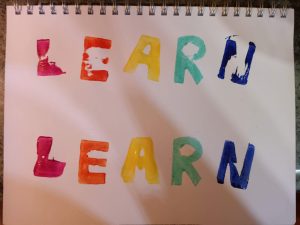
As an art teacher and generally artsy person, I thoroughly enjoyed the opportunity to work in a medium connected with the arts for this task. Throughout my progress in the MET, I have come to realize the importance of the arts and the role they play in our communication. To me, art is a text; works of art can be read. Colours, shapes, lines, and the other elements and principles of art can be used to tell stories. Authors and artists both create work that falls along a spectrum; it is difficult to identify distinct categories between art and writing.
Once I settled on a word, the whole process took about 30 minutes, most of which was spent crafting the stamps. I consciously chose uppercase letters, believing they would be easier since they generally have fewer curves. The A and R were the most challenging letters to create because of the need to remove material from the center of the letter. I was very aware that I needed to carve the letters backwards so that when printed they would have the correct orientation. I struggled the most with the letter N and was not convinced I had it right until I actually lifted the print. I chose to use different colours for each letter because of my artsy personality; this was feasible because each letter was separate from the other. For me, the use of colour further obscures the distinction between writing and art.
In their podcast, Lamb and McCormick (2021) explored the idea of what defines a book; they distinguished between books or codices and scrolls. As I listened to the podcast, I was reminded of an artist I have been following on social media, Geo Rutherford. When I first saw her work and heard her refer to it as a book, I thought it was stretching the word ‘book’ quite far; but my understanding is growing increasingly as I proceed through this course. Lamb and McCormick (2021) described Andrew Robinson’s definition of a book as being made for public circulation, having relative permanence, being relatively portable and being capable of knowledge transmission through space and time. According to this definition then, Rutherford’s artwork is indeed a book. Rutherford (2020) herself stated that her book challenges our expectations of what books are. She further described the substantial amount of time that went into making these books. Historically, written books also required a considerable dedication of time.
Until relatively recently in the history of writing, books have required a significant amount of time and effort to be produced. Lamb and McCormick (2021) described that prior to the printing press, books were copied by hand, which was obviously slow, but the process was further delayed by the need to wait for the ink to dry. Even once the printing press was invented, creating books was still time consuming; Paul Collier described the process of using moveable type as a slow process that “requires a great degree of consideration” (Cooke, 2012). When creating my stamps, I also used a good deal of thought especially regarding orientation. Collier described that the quality of image produced from the letterpress is sought after as it is not seen often anymore. He further refers to it as an art form (Cooke, 2012). Again, the distinction between writing and art is blurred. I see my print as a work of art. The colours, the quality of the print, and the crooked letters all create a whimsical sort of image that says a lot more than the simple word repeated on the paper. Afterall, “a picture is worth a thousand words.”
References
Cooke, D. (2012, January 26). Upside down, left to right: a letterpress film [Video]. Youtube. https://www.youtube.com/watch?v=n6RqWe1bFpM&ab_channel=DannyCookeFreelanceFilmmaker
Lamb, R., & McCormick, J. (Hosts). (2021, May 8). From the Vault: Invention of the Book, Part 1 [Audio podcast episode]. In Stuff to Blow Your Mind. https://www.iheart.com/podcast/stuff-to-blow-your-mind-21123915/?keyid%5B0%5D=Stuff%20To%20Blow%20Your%20Mind&keyid%5B1%5D=From%20the%20Vault%3A%20Invention%20of%20the%20Book%2C%20Part%201&sc=podcast_widget
Rutherford, G. (2020, December 9). Artist books explore beauty and fragility of great lakes ecosystem [Interview]. Wisconsin Public Radio. https://www.wpr.org/listen/1699276
Hi Lexie,
I really enjoyed seeing your perspective as an art teacher. If you would like to see my linking assignment, you can find it at the following link: https://blogs.ubc.ca/etec540sprott/linking-assignment/link-2/